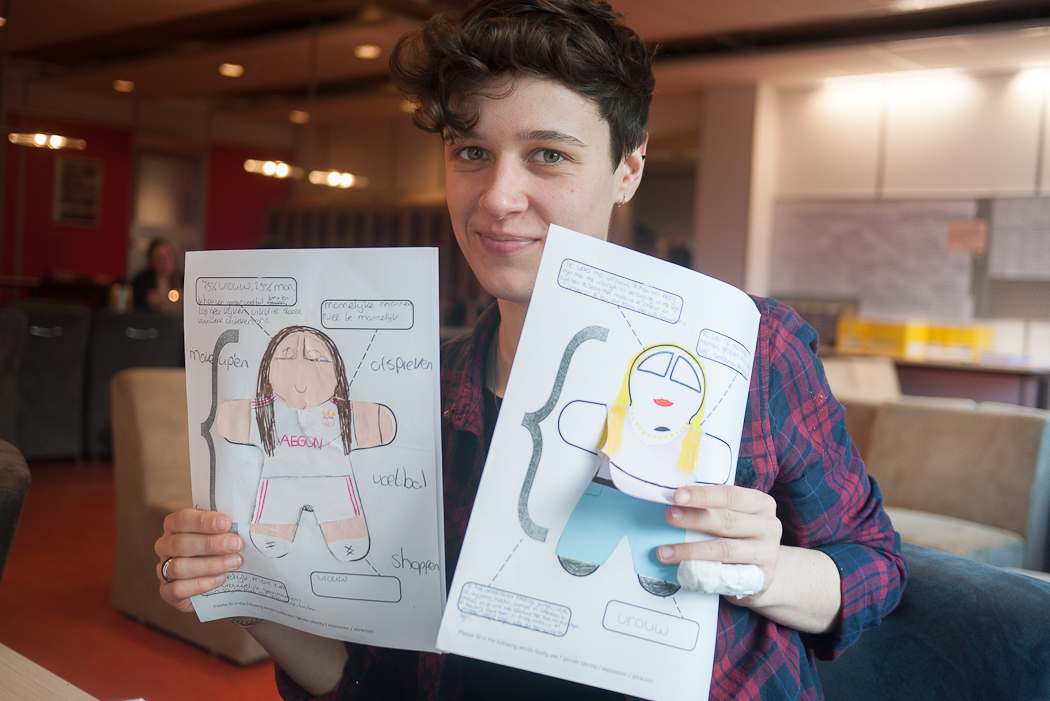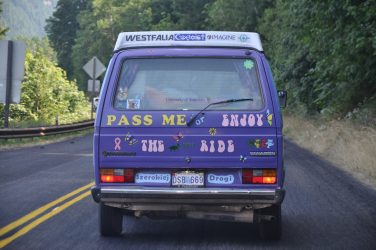A group of Dutch educators and campaigners are on a mission to change the way young people think about gender and sexual identity. Their secret weapon: biscuits. Petya Yankova visited a Genderbread workshop and talked to one of the project’s founding members about gender theory, baking and what it means to be “normal”.
It’s a stiflingly hot Sunday afternoon as I make my way through the crowds of tourists outside Amsterdam Central Station. The tidal wave of tourists reminds me that the city is preparing for the forthcoming Pride parade in a few days. Twenty minutes later I am in a quiet hotel far away from the centre. The talk is beginning. There is the usual flipchart and video, but beside these seminar staples I spot jars of gingerbread and a big recipe book. What kind of a lesson is this?
I am attending a workshop on new ways of teaching the difference between sex and gender in formal and non-formal education. Two young and friendly faces welcome the audience and bring up a difficult topic: how to teach, and even talk to school children about sexual diversity and its expression. Mixing the same ingredients in different portions to produce a subtly diverse range of gingerbread biscuits, the educators explain how humans too are all made of the same ingredients: it is only the ratios that differ. We may vary in appearance, sexual attraction or gender identity, but our essential characteristics are alike.

The session I witnessed included deconstructing the social concepts of “man” and “woman” before giving each participant a chance to create their own biscuit – whether by drawing or actually baking. Simultaneously running videos presented the creation of the biscuit – from the mixing of sugar, flour and butter to the final decorative touches. Every new addition to the biscuit – sugar-coated trousers, marzipan crown, a screwdriver – creates new interpretations of gender identity.
The Genderbread Kit started as a university assignment, bringing together the expertise and enthusiasm of a designer, an advisor specialising in gender studies and a teacher. Through interactive materials, fact files, thought-provoking games and simple examples, the creative team manages to put across an idea which still travels slowly in European society: the importance of understanding and accepting differences.
Their work was first showcased at a graduate school exhibition, before being offered as test lessons in several Dutch high schools. Having been proved quite successful, the lesson pack is now entering more and more schools. In recent months, its creators have joined forces with various national and international initiatives promoting gender equality, freedom of expression and raising awareness about LGBT issues. At the centre of their work is the drive to reach out and speak directly to young people about the complexities of gender identity: one member of the project team, for instance, was interviewed for a Dutch children’s television programme by a 12-year child, who questioned her about what it means to be neither a girl, nor a boy.
E&M caught up with Jo Lamers, the concept theorist behind the project, about inspiration, education systems, deconstructing myths and baking biscuits.
E&M: What inspired you to take up the subject of sex and gender education?
JL: For both Lea [the project designer] and me this topic is a personal one. We both identify with being (gender) queer and this has influenced our development quite a bit. Lea was from a young age on very adamant about not being a girl and was very creative with her expression during her teens. She made being “weird” something to be proud of and didn’t mind standing out. I, on the other hand, tried very much to conform and be as “normal” as possible. But that caused me to feel very sad and confused. I chose to do a master’s in Gender Studies more as a self-study and only while studying Queer Theory did I find the words to describe my gender queer identity.
During the many talks we had about this topic before we started working on the Genderbread Kit, both Lea and I agreed that some kind of education around gender and sexual diversity in primary or secondary school would have helped our personal development so much! We both felt different, weird, confused, but we couldn’t explain why. That is the main reason behind us taking up the subject of sex and gender education: to give words and deconstruct the social constructs that make diversity invisible.
We found it important to not only talk about the other, that is “the homosexual” or “the transgender”. We talk about everybody in the classroom. Nobody fits the stereotype of “normal man” or “normal woman”. Everybody is unique. With this we create a “we” feeling (inclusiveness) in the classroom. It is not an “us versus them”.
E&M: What is the social context in which the Genderbread Kit emerged?
JL: In the last two years, the topic of “transgender” has become more prominent in Dutch media. Because of that, or maybe preceding that, there is also a need to discuss this topic in schools. How do you ensure a school is a safe place for a child that wants to come out as transgender? How do you answer the questions of the other students? These dilemmas often confront teachers who are looking for ways to have a more open dialogue about diversity in sexualities and in identities.

Another way in which you can tell that this is a hot topic here in the Netherlands is that since 1 December 2012, in accordance with Dutch governmental agreements, teaching about gender- and sexual diversity has been a mandatory part of the curriculum in both primary and secondary education. Although it is incorporated into subjects such as sociology, social philosophy, biology, and personal care, teaching about diversity in identities is still an underexposed topic.
E&M: What happens in the classroom during the lesson? How do teachers and students react to it?
JL: We are lucky to be able to say that we have only received positive feedback so far. We enjoy giving the workshop and I think that shows. Sometimes we come across skeptical teachers who have very rigid heteronormative views on society, but mostly teachers thank us for helping them tackle this topic in their classroom. They find it difficult to really go into the topic of gender identity and diversity because of lack of personal knowledge on the subject.
The students are attentive and have an active approach to the assignments we give them during their class. And of course the fact that we hand out biscuits at the end wins them over completely.
Some comments that we received from students were that the workshop had a “good tempo, challenging assignments and friendly guest lecturers”. One of the students stated that they found the lesson funny because of the class’s reaction to the presenters. “They were friendly and I think that they did a good job. They were open and not nervous. I enjoyed it” is another review we have received after delivering the lesson.
E&M: What are your future plans?
JL: We are currently translating the lesson package to Dutch, our goal is to have the translation and digitalised package ready by mid-September. We are also teaming up with the Dutch organization Rainbow City Rotterdam, who are going to take up our workshop in their offer. This way, Rainbow City Rotterdam can give the workshops as well – with the help of their 40 volunteers – and more kids will be reached. And our last goal for this school year is to expand our network and get in touch with international organisations to work together on getting the discussion about gender and sexual diversity in schools all over Europe.
Cover photo: The Genderbread Kit









